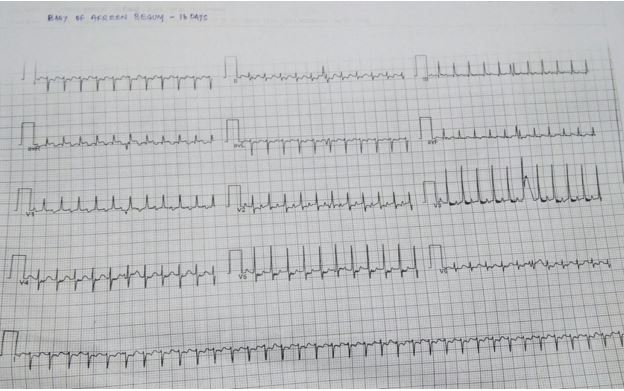A CASE OF REFRACTORY SUPRAVENTRICULAR TACHYCARDIA IN A NEWBORN.
Abstract
Supraventricular Tachycardia (SVT) is the most common neonatal dysrhythmia with incidence being 1 in 100 for children of all ages and 1 in 250 for neonates. Origin of Supraventricular tachycardia is either above the bifurcation of the bundle of His or it has mechanisms dependent on the bundle of His. Newborns may present with irritability, poor feeding and tachypnea. The most important clinical signs of SVT is tachycardia sometimes associated with hypotension, heart failure, pallor, or decreased level of consciousness. Diagnosis is done with heart rate continuously remaining ≥ 220 beats per minute with a QRS < 0.08 seconds. Adenosine is the first-line abortive therapy of choice. Intractable SVTs are treated with amiodarone, esmolol, and procainamide. SVT with Circulatory collapse needs a synchronized DC cardioversion. Prognosis of SVT is generally excellent in the absence of structural heart disease.
Downloads
References
2. Fox DJ, Tischenko A, Krahn AD, Skanes AC, Gula LJ, Yee RK, et al. Supraventricular tachycardia: diagnosis and management. Mayo Clin Proc. 2008; 83(12) : 1400 -11.
3.Nadas ASDaeschner CWRoth ABlumenthal SL Paroxysmal tachycardia in infants and children: study of 41 cases. Pediatrics 1952;9 (2) 167- 181.
4.Perry JCGarson A Jr Supraventricular tachycardia due to Wolff-Parkinson-White syndrome in children: early disappearance and late recurrence. J Am Coll Cardiol 1990;16 (5) 1215- 1220.
5.Deal BJKeane JFGillette PCGarson A Jr Wolff-Parkinson-White syndrome and supraventricular tachycardia during infancy: management and follow-up. J Am Coll Cardiol 1985;5 (1) 130- 135.
6.Giardina ACEhlers KHEngle MA Wolff-Parkinson-White syndrome in infants and children: a long-term follow-up study. Br Heart J 1972;34 (8) 839- 846.
7. Garson ABricker JT McNamara DG The Science and Practice of Pediatric Cardiology. Philadelphia, PA Lea & Febiger1990.
8. Garson A JrGillette PC McNamara DG Supraventricular tachycardia in children: clinical features, response to treatment, and long-term follow-up in 217 patients. J Pediatr 1981; 98 (6) 875- 882.
9. Wong KK, Potts JE, Etheridge SP, Sanatani S. Medications used to manage Supraventricular tachycardia in the infant a North American survey. Pediatr Cardiol. 2006;27:199–203.
10. Tavera MC, Bassareo PP, Neroni P, Follese C, Manca D, Montis S, et al. Supraventricular tachycardia in neonates: antiarrhythmic drug choice dilemma. J Matern Fetal Neonatal Med. 2010;23(Suppl 3):30–3.
11. Brugada J, Blom N, Sarquella-Brugada G, Blomstrom-Lundqvist C, Deanfield J, Janousek J, et al. Pharmacological and non-pharmacological therapy for arrhythmias in the pediatric population: EHRA and AEPC-Arrhythmia Working Group joint consensus statement. Europace. 2013;15:1337–82.
12. Texter KM, Kertesz NJ, Friedman RA, Fenrich AL., Jr Atrial flutter in infants. J Am Coll Cardiol. 2006;48:1040–6.
13. Van Gelder IC, Tuinenburg AE, Schoonderwoerd BS, Tieleman RG, Crijns HJ. Pharmacologic versus direct-current electrical cardioversion of atrial flutter and fibrillation. Am J Cardiol. 1999;84:147R–51R.
14. Chang PM, Silka MJ, Moromisato DY, Bar-Cohen Y. Amiodarone versus procainamide for the acute treatment of recurrent supraventricular tachycardia in pediatric patients. Circ Arrhythm Electrophysiol. 2010;3:134–40.
15. Manole MD, Saladino R. Emergency department management of the pediatric patient with supraventricular tachycardia. Pediatr Emerg Care. 2007;23:176–85.
16. Weindling SN, Saul JP, Walsh EP. Efficacy and risks of medical therapy for Supraventricular tachycardia in neonates and infants. Am Heart J. 1996;131:66–72.
17. Seslar SP, Garrison MM, Larison C, Salerno JC. A multi-institutional analysis of inpatient treatment for supraventricular tachycardia in newborns and infants. Pediatr Cardiol. 2013;34:408–14.
19. Jonathan Lewis, Gaurav Arora, Dana L. Tudorascu, Robert W. Hickey, Richard A. Saladino, and Mioara D. Manole.Acute Management of Refractory and Unstable Pediatric Supraventricular Tachycardia. J Pediatr 2017;181:177-82).
20. Clausen H, Theophilos T, Jackno K, Babl FE. Paediatric arrhythmias in the emergency department. Emerg Med J 2012;29:732-7.
21. Till J, Shinebourne EA, Rigby ML, Clarke B,Ward DE, Rowland E. Efficacy and safety of adenosine in the treatment of Supraventricular tachycardia in infants and children. Br Heart J 1989; 62:204-11.
22. Ralston MA, Knilans TK, Hannon DW, Daniels SR. Use of adenosine for diagnosis and treatment of tachyarrhythmia in pediatric patients. J Pediatr 1994; 124:139-43.
23. JACK C. Salerno, MD; Stephen P. Seslar, MD, PhD Supraventricular Tachycardia. Arch Pediatr Adolesc Med. 2009; 163(3):268-274. doi: 10.1001/archpediatrics.2008.547.
24. Munger TM Packer DL Hammill SC et al. A population study of the natural history of Wolff-Parkinson-White syndrome in Olmsted County, Minnesota, 1953-1989. Circulation 1993;87 (3) 866- 873.

Copyright (c) 2023 Author (s). Published by Siddharth Health Research and Social Welfare Society

This work is licensed under a Creative Commons Attribution 4.0 International License.


 OAI - Open Archives Initiative
OAI - Open Archives Initiative


